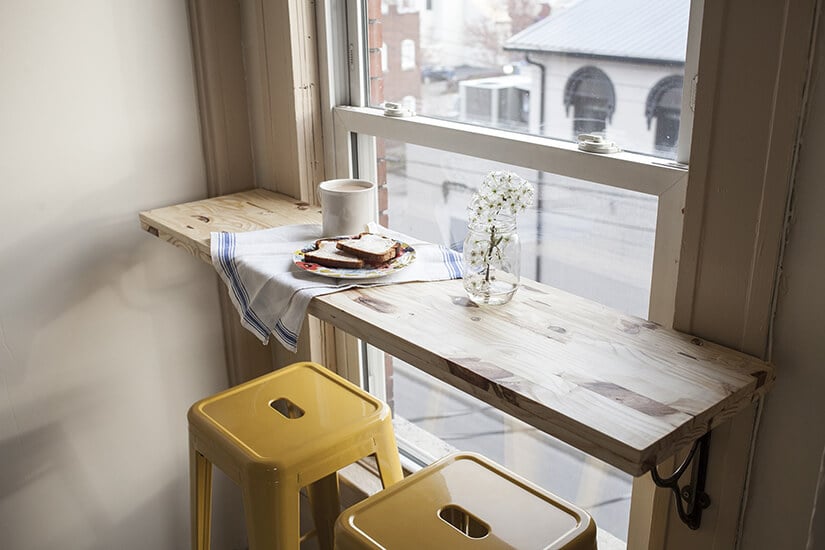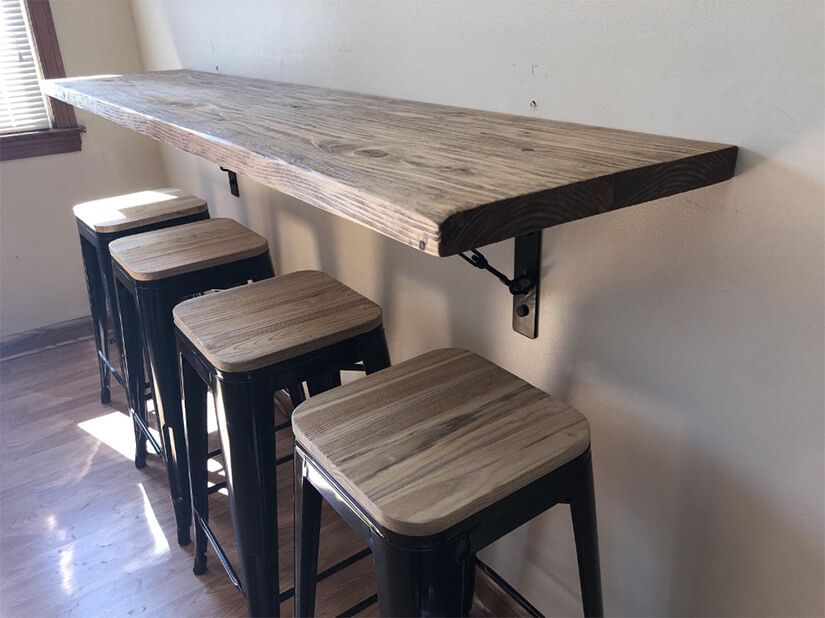design
How To Build A Breakfast Bar
The breakfast bar could be one of the most versatile spots in the home, and it’s not just for breakfast. It can double as a homework station, computer lounge, informal date night spot, and extra counter space for dinner prep. It can also be one of the simplest upgrades you can make to your kitchen.
Today, we’re going to talk all about how to build a breakfast bar. You’ll see that it’s pretty easy. It boils down to two things: a surface and support for that surface.
Home Vs. Apartment

You’ll obviously have a few more options if you plan to install a breakfast bar in your own home. If you’re renting a home or an apartment, you’ll have to keep the installation minimal?by not knocking down any walls or ripping out any carpet, for example.
However, you can install a non-invasive breakfast bar in an apartment with no problem. You could either build a bar on top of a couple modular cabinets that rest on the floor, or you could attach a bar top to studs in a wall. The second option is particularly easy and cost-effective, and it works in any kind of home as well.
Plan The Design
The design of your DIY breakfast bar depends on the layout of your kitchen (or whatever room you’re adding it to). You want to make sure that you have adequate clearance around doors, cabinets, and appliances.
Your bar should leave 36-42 inches of space to the front and to the sides if it’s next to a doorway. You might be inspired by a beautiful piece of reclaimed wood, but it wouldn’t be so beautiful if everyone keeps bashing into the corner after it’s installed.
You also need to think about the height of your bar. Most bar stools come in sizes that will fit a bartop that’s either 36 or 42 inches. A 42-inch top will feel more like a bar to most people, and it’s 6 inches higher than a standard countertop.
This is when you’ll want to decide if your bar should go lengthwise along a wall, jut out from a wall, or extend from an island. A typical bar top is 14 to 18 inches deep, but you can get away with 12 inches if you need to.
Choose Your Top
Here’s where it starts to get fun. Do you want your bar top to match your countertops or contrast them? If you think your bar will get a lot of traffic, it would be good to choose a durable material. On the other hand, you could build a modern bar with a glass top if you aren’t going to be throwing your keys or heavy objects onto it.
Whether your kitchen is modern or traditional, a simple bar made from oiled wood always looks great. Since a bartop isn’t subjected to the food prep work that a countertop is, you can use more exotic pieces of wood with pores and knots showing.
Wood bar tops are pretty easy to install, and you can even use wood cutting stations at hardware stores to build the top yourself. On the other hand, if you want to use marble, you’ll either have to have a lot of experience or work with a contractor on the installation.
Choose The Right Supports And Assemble

First, let’s talk about a bar that is installed along a wall. Here, you have a couple of options. You could build support legs out of two-by-fours with a couple of diagonal beams on the backside. In essence, this would be a long table that you set up against the wall.
But the easier option would be to use supports drilled into wall studs. To do this, you could use diagonal pieces of wood, wood corbel braces, or metal countertop brackets. Three stud supports can hold up a 6-foot wood bar top, but you can add supports at each stud if you’re worried about the weight.
If you’re building a breakfast bar that comes out lengthwise from a wall, you can use the stud support approach at the wall. However, you’ll also need to build support legs at the end of the bartop and maybe in the middle if it’s long. If you don’t want to drill holes into your floor, you can attach a foot on each leg to distribute the weight.
Now, if you’re building a breakfast bar off of an island or out from a blank side of your lower cabinets, things can get a little complex. The easiest thing to do would be to find one or two matching cabinets and use those for the base of the bar. You can space them out to have legroom in the middle, too.
If your island has a long and flat enough side, you might be able to add a lightweight wood bartop to that side with stud supports. Kitchen islands have studs, but if your island has deep molding or a facade of another material, you won’t be able to secure the supports to the studs very easily.
Finally, you could also build a table-type breakfast bar and install it along one side of your island. That way, you could make the bar higher than the island, too.
Once you have your bartop cut to size and your supports figured out, all that’s left is to assemble the bar. Remember to use a good stud finder to locate studs and a level to make sure everything is straight.
![See your dream kitchen in 3D [GET YOUR FREE DESIGN]](https://cdn.kitchencabinetkings.com/blog/wp-content/uploads/see-your-dream-kitchen-in-3d.webp)
![Contractor Discount Program: Offering contractors and builders special volume discounts on all applicable orders [LEARN MORE]](https://cdn.kitchencabinetkings.com/blog/wp-content/uploads/contractor-discount-program.webp)
![Explore our photo gallery [GET INSPIRED]](https://cdn.kitchencabinetkings.com/blog/wp-content/uploads/explore-our-photo-gallery.webp)
![What everyone is saying about KCK [READ REVIEWS]](https://cdn.kitchencabinetkings.com/blog/wp-content/uploads/what-everyone-is-saying-about-kck.webp)
![Get a cabinet sample [SHOP SAMPLES]](https://cdn.kitchencabinetkings.com/blog/wp-content/uploads/get-a-cabinet-sample.webp)
![Pay over time, on your terms with Affirm [LEARN MORE]](https://cdn.kitchencabinetkings.com/blog/wp-content/uploads/pay-over-time-on-your-terms-with-affirm.webp)